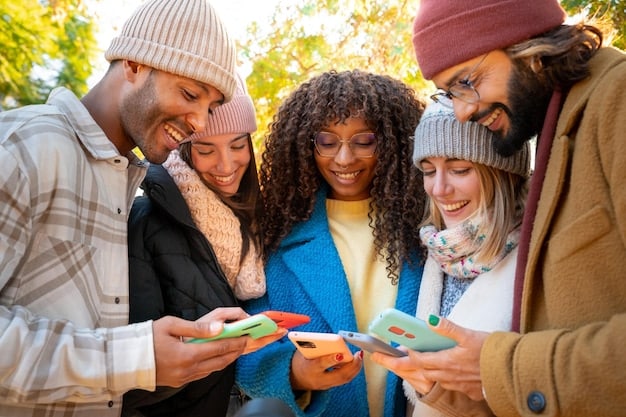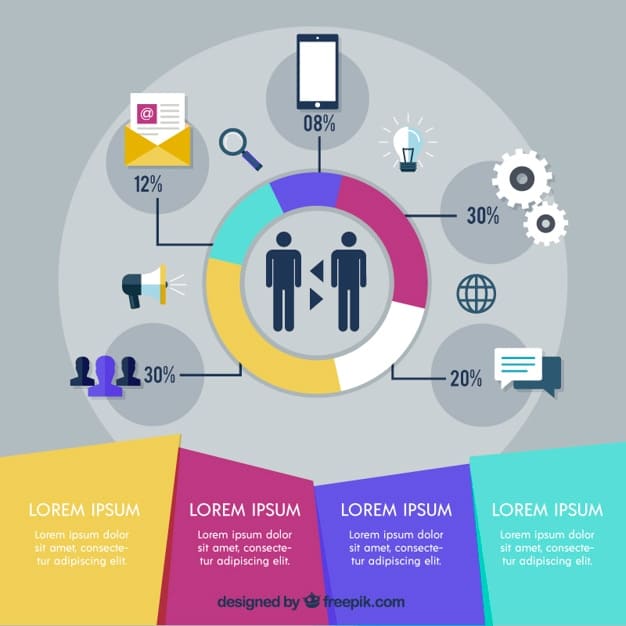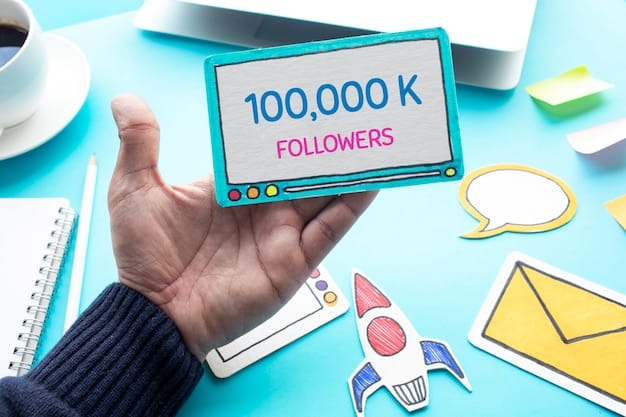User Engagement Now: Influencer Marketing’s Impact on Social Media Rates

User Engagement Now: The Impact of Influencer Marketing on Social Media Engagement Rates is significant, as influencers drive interactions and build community, shaping brand perception and loyalty in a measurable way.
In today’s digital landscape, understanding User Engagement Now: The Impact of Influencer Marketing on Social Media Engagement Rates is crucial for businesses seeking to amplify their brand presence. Influencer marketing has emerged as a powerful tool for connecting with audiences, fostering community, and driving meaningful interactions. Let’s explore how this strategy impacts user engagement and how you can leverage it effectively.
Understanding Influencer Marketing and User Engagement
Influencer marketing has become a cornerstone of modern digital strategies, offering a direct line to target audiences. By partnering with individuals who have established credibility and a dedicated following, brands can tap into existing communities and foster meaningful interactions.
User engagement, in turn, is the lifeblood of social media success. It encompasses likes, comments, shares, and overall participation within a brand’s online ecosystem. Boosting these metrics is essential for increasing brand visibility, building customer loyalty, and driving conversions.
What is Influencer Marketing?
At its core, influencer marketing involves collaborations between brands and influencers to promote products, services, or campaigns. These influencers leverage their platforms and audiences to create engaging content that resonates with their followers.
The key here is authenticity. Unlike traditional advertising, influencer marketing thrives on genuine connections and relatable content. When influencers are passionate about the brands they represent, their enthusiasm translates into higher engagement rates.
The Essence of User Engagement
User engagement encompasses a range of interactions that signal a positive connection between a brand and its audience. These interactions include:
- Likes and Reactions: Simple indicators of approval and interest.
- Comments and Discussions: Opportunities for direct interaction and feedback.
- Shares and Retweets: Amplification of content to a broader audience.
- Saves and Bookmarks: Signals of longer-term interest and value.
These engagement metrics are not just vanity numbers; they provide valuable insights into audience preferences, content performance, and overall brand sentiment.

In conclusion, understanding the dynamics between influencer marketing and user engagement is the first step toward crafting effective strategies. By leveraging the power of credible voices and focusing on authentic content, brands can unlock new opportunities for connecting with their target audiences.
The Impact of Influencer Marketing on Social Media Metrics
Influencer marketing’s impact on social media extends far beyond simple product endorsements. When implemented strategically, it can drastically improve key metrics, leading to increased brand visibility and customer loyalty.
Engaging content, when shared by a credible influencer, can prompt immediate and sustained user activity. This impact spans a multitude of platforms and caters to diverse audience demographics.
Boosting Likes and Shares
One of the most immediate impacts of influencer marketing is the surge in likes and shares. When influencers share content that resonates with their audience, followers are more likely to engage with it.
Influencers are adept at creating shareable content that aligns with their audience’s interests and values. By tapping into this expertise, brands can amplify their message and reach a wider audience organically.
Driving Comments and Discussions
Beyond superficial engagement, influencer marketing can also drive meaningful conversations. Influencers often encourage their followers to share their thoughts, ask questions, and participate in discussions.
- Interactive Content: Polls, Q&A sessions, and live streams can foster real-time engagement.
- User-Generated Content (UGC): Encouraging followers to share their experiences with a brand can build trust and authenticity.
- Contests and Giveaways: Incentivizing participation can drive a surge in comments and discussions.
By fostering these interactions, brands can gain valuable insights into customer sentiment and build stronger relationships with their audience.
To summarize, influencer marketing has a proven ability to elevate social media metrics. The impact is seen not only in increased likes and shares but more importantly, in the generation of meaningful discussions and lasting connections between the brand and its followers.

Strategies for Optimizing Influencer Marketing Campaigns
The success of an influencer marketing campaign depends heavily on planning, execution, and ongoing optimization. A well-crafted strategy ensures that resources are used effectively and yields maximum engagement.
Optimizing campaigns requires careful attention to detail, from selecting the right influencers to monitoring campaign performance and making data-driven adjustments.
Selecting the Right Influencers
Choosing the right influencers is pivotal. Alignment with their values and audience is paramount. Factors to consider include:
- Relevance: Does the influencer’s content align with your brand’s values and target audience?
- Reach: How many followers does the influencer have, and what is their demographic profile?
- Engagement Rate: How actively engaged is the influencer’s audience? What is the average number of likes, comments, and shares per post?
- Authenticity: Does the influencer have a genuine connection with their audience, and do they disclose sponsored content transparently?
Creating Compelling Content
Content should be engaging, informative, and aligned with the influencer’s style and the brand’s objectives. Collaborate with influencers to create unique content that resonates with their audience.
Consider different formats, such as videos, stories, live streams, and interactive posts. Regularly A/B test different types of content to identify what performs best.
Measuring and Analyzing Results
Track key performance indicators (KPIs) such as engagement rate, reach, website traffic, and conversions. Use analytics tools to monitor campaign performance and identify areas for improvement.
- Engagement Rate: Divide the total number of engagements (likes, comments, shares) by the number of followers.
- Reach: Measure the number of unique users who have seen the content.
- Website Traffic: Track the number of visitors who come to your website from influencer marketing campaigns.
In summary, optimizing influencer marketing campaigns involves strategic influencer selection, content creation, and relentless data analysis. By focusing on authenticity and engagement, brands can maximize the impact and ROI of their influencer marketing efforts.
Tools and Technologies for Enhancing User Engagement
In today’s digital age, a variety of tools and technologies can amplify user engagement within influencer marketing campaigns. These platforms streamline campaign management, enhance content creation, and provide in-depth analytics.
From social listening tools to advanced analytics dashboards, businesses have access to resources that can significantly augment the effectiveness of their marketing endeavors.
Social Listening Tools
Social listening tools allow businesses to monitor online conversations, track brand mentions, and gauge audience sentiment. These tools can help identify potential influencers, uncover trending topics, and track campaign performance in real-time.
Popular social listening tools include:
- Brandwatch: Provides detailed insights into brand reputation and audience behavior.
- Mention: Tracks brand mentions across multiple platforms.
- Hootsuite Insights: Offers real-time analytics and social media monitoring.
Content Creation Tools
High-quality content is essential for driving user engagement. A variety of tools can help create visually appealing graphics, engaging videos, and interactive posts.
Some content creation tools to consider:
- Canva: Simplifies graphic design with pre-designed templates and easy-to-use features.
- Adobe Creative Cloud: Offers a suite of professional-grade design tools for creating high-quality content.
- Filmora: An accessible video editing software for creating engaging videos.
Analytics Dashboards
Comprehensive analytics dashboards provide valuable insights into campaign performance. These dashboards track KPIs such as engagement rate, reach, website traffic, and conversions.
Examples of analytics dashboards include:
- Google Analytics: Tracks website traffic and user behavior.
- Facebook Analytics: Provides insights into Facebook page performance.
- Instagram Insights: Offers data on audience demographics and content engagement.
Ultimately, leveraging the right tools and technologies is crucial for maximizing user engagement. Social listening tools, content creation platforms, and detailed analytics dashboards empower brands to refine their influencer marketing strategies.
Measuring the ROI of Influencer Marketing
Determining the return on investment (ROI) of influencer marketing is crucial for justifying marketing spend and optimizing future campaigns. Assigning values to engagement and leveraging data become key to a clear understanding.
ROI measurements offer insights into what’s working, what’s not, and how to refine strategies for maximum effectiveness.
Key Performance Indicators (KPIs)
Start by identifying the KPIs aligned with the goals. These may include:
- Engagement Rate: The percentage of followers who interact with the content.
- Reach: The number of unique users who view the content.
- Website Traffic: The number of visitors who come to the website from influencer campaigns.
- Conversions: The number of sales or leads generated as a result of the campaign.
Attribution Modeling
Attribution modeling helps determine which touchpoints in the customer journey are responsible for driving conversions. Different attribution models include:
- First-Touch Attribution: Gives credit to the first touchpoint that a customer interacts with.
- Last-Touch Attribution: Attributes the conversion to the final touchpoint before the purchase.
- Multi-Touch Attribution: Distributes credit across multiple touchpoints.
Calculating ROI
To calculate the ROI of influencer marketing, compare the total revenue generated by the campaign to the total cost of the campaign.
ROI = (Revenue – Cost) / Cost x 100%
For example, if a campaign generates $10,000 in revenue and costs $2,000, the ROI would be:
ROI = ($10,000 – $2,000) / $2,000 x 100% = 400%
This signifies that for every dollar spent, the campaign generated four dollars in revenue. Comprehensive metrics such as these are vital in ascertaining the true impact of any influencer campaign.
In closing, measuring the ROI of influencer marketing requires strategic KPI identification, attribution modeling, and ROI calculation. A data-driven approach can optimize campaigns and maximize returns.
Future Trends in Influencer Marketing
Influencer marketing is a dynamic landscape, constantly evolving with changing consumer behaviors and technological advancements. Staying ahead of these trends is essential for maintaining a competitive edge.
Emerging technologies such as AI, evolving regulatory landscapes, and shifting platform dynamics will collectively reshape the influencer marketing sphere.
The Rise of Micro-Influencers
Micro-influencers, with smaller but highly engaged audiences, are gaining traction. These influencers often have a closer relationship with their followers, resulting in higher engagement rates.
Brands are increasingly partnering with micro-influencers to reach niche audiences and build authentic connections. This approach is particularly effective for local businesses and specialized product categories.
AI-Powered Influencer Marketing
Artificial intelligence (AI) is transforming influencer marketing by automating tasks, enhancing content creation, and improving campaign targeting. AI-powered tools can:
- Identify Influencers: Analyze data to identify influencers who are most relevant to a brand’s target audience.
- Create Content: Generate engaging content using AI writing and design tools.
- Optimize Campaigns: Adjust campaign parameters in real-time based on performance data.
The Metaverse and Virtual Influencers
As the metaverse continues to develop, virtual influencers are becoming more prevalent. These computer-generated characters can interact with audiences in virtual worlds, offering unique brand partnership opportunities.
Brands are experimenting with virtual influencers to reach new audiences and create immersive experiences. The lines between virtual and real-world marketing continue to blur, opening up new frontiers for influencer campaigns.
| Key Aspect | Brief Description |
|---|---|
| 📈 Engagement Metrics | Likes, comments, & shares drive brand visibility & loyalty. |
| 🎯 Influencer Selection | Relevance, reach, and authenticity are key factors. |
| 🤖 AI Utilization | AI tools enhance content creation and improve campaign targeting. |
| 🌐 ROI Calculation | Measure campaign revenue against costs for insights. |
Frequently Asked Questions
▼
Influencer marketing can significantly boost engagement by leveraging trusted voices to promote your brand. When followers see influencers they trust endorsing a product, they are more likely to interact with the content.
▼
Key metrics include engagement rate, reach, website traffic, and conversion rates. Tracking these metrics provides insight into the effectiveness and impact of the influencer campaign on audience behaviors.
▼
Consider relevance, reach, engagement rate, and authenticity when selecting influencers. Ensure their values align with your brand and that their audience matches your target demographic. Consider the influencer’s specific niche.
▼
AI improves influencer selection, automates content creation, and optimizes campaign targeting. This helps improve efficiency for businesses, particularly in measuring and analyzing the results of a marketing campaign.
▼
Calculate ROI by comparing the revenue generated by the campaign to its costs, using metrics like conversion rates and website traffic. This information provides direct insight into profits gained from the campaign.
Conclusion
Incorporating influencer marketing into your broader social media strategy represents a powerful means of amplifying user engagement. Careful influencer selection, creative content development, and consistent campaign analysis are essential for generating noticeable increases in key metrics and establishing enduring brand connections. As influencer marketing continues to evolve, keeping informed and adaptable ensures the achievement of meaningful marketing outcomes.





